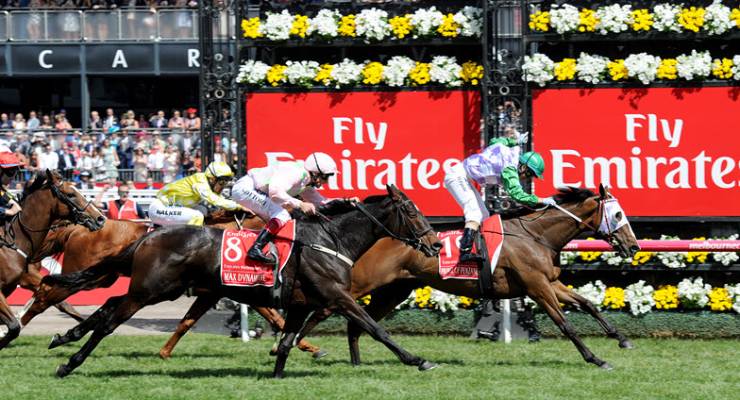
This is a brief extract from Titus O’Reily’s upcoming book A Thoroughly Unhelpful History of Australian Sport, published Monday, October 30.
HORSERACING: Sport of kings and degenerate gamblers
Fine cotton and other controversies
Racing folk have shown a level of artistry and creativity in fixing races that matches the painters of the Renaissance. From whips with electric shocks in them to doping, from painting horses to trapdoors, there’s a good reason many suspect horseracing isn’t on the level: the constant evidence that it isn’t on the level.
I have so many favourite racing scams that one book can contain only a fraction. One of my favourites happened in 1939, when Harry Solomon called a race in Melbourne on 3XY — after cutting the wires to the other radio stations — and in his made-up version of the race, the horse he had put money on won the race. His “winner” was a horse called Buoyancy, which was paying 6 to 1. Solomon was investigated, after all there had been an actual race run and people saw it, but he had skipped the country. He was found about six months later in Fiji and brought home to serve six months in jail.
Another favourite was when in 1955 a long shot, Thundering Legion, saw a massive betting plunge in its favour. The chief steward confronted the jockey and snatched his whip, only to get an electronic shock. The jockey, Bill Attrill, admitted to giving electric shocks to the horses he was riding to help him win. He was kicked out of racing for 10 years.
While electrocuting horses is something most people frown upon, this next scam at least showed a level of creativity you can admire. In 1903, a horse called Gentleman Jim was given huge odds due to carrying a lot of weight. The horse was owned by Jim “The Grafter” Kingsley, one of those colourful racing identities Australia specialises in. After winning the race, Kingsley was told by the steward that the jockey was 13 kilograms light. Kingsley said this couldn’t be true and stamped the floor. They weighed the jockey again and he was found to be at the correct weight. The stewards, however, decided to inspect the scales and found a trapdoor underneath that revealed a boy holding a 13-kilogram weight. Other scales were inspected where Gentleman Jim had previously raced, revealing similar set-ups. Just imagine if these people had devoted themselves to doing good.
Perhaps the most famous racing scam was the Fine Cotton affair, known mostly for its farcical execution. Fine Cotton was a horse that raced in Queensland. It wasn’t particularly good. The syndicate that owned it came up with the grand plan of getting an identical horse called Dashing Solitaire, which was much better, racing it as Fine Cotton, and betting big on it winning at long odds.
Here’s where things get tricky. When Dashing Solitaire was injured, the syndicate decided to buy a horse called Bold Personality to race as the ring-in instead. Bold Personality was a lot better than Fine Cotton but unfortunately it was also a completely different colour, which was not ideal for the scam. This was probably the moment to pull up stumps, but what the syndicate lacked in brains they made up for with commitment.
They decided the sensible thing to do was dye the horse’s hair using off-the-shelf human hair dye. This was not a fit-for-purpose solution and the results were literally and figuratively patchy. Even worse, on the day of the race they remembered that Fine Cotton had some white markings on its rear legs and they decided a bit of white paint would sort that out.
On the day of the race, betting markets across the country began to put a lot of money on “Fine Cotton”, slightly weird for a horse racing in a minor race in Queensland, especially one that was a massive outsider. Despite suspicions, the race was run and “Fine Cotton” won narrowly.
Immediately after the race, an investigation was launched. By the time the horse was taken to be weighed, the paint was starting to run. A request for Fine Cotton’s trainer to show the horse’s registrations papers resulted in him fleeing the course, another subtle hint that something was up.
Not long after that, “Fine Cotton” was disqualified and the syndicate lost all the money it had put on the ring-in. The official inquiry resulted in six people being banned for life, and Bill and Robbie Waterhouse were banned for 14 years due to having prior knowledge of the scam.
Robbie is the husband of prominent trainer Gai Waterhouse, and his son Tom Waterhouse had an online gambling business, where Robbie was a company director before it was sold to a big British bookmaker. That’s the thing about the racing industry, it’s so insular that people don’t even raise an eyebrow at all that.
That’s the wonder of horseracing: power, money and people with questionable morals, all gilded with glamour.







Crikey is committed to hosting lively discussions. Help us keep the conversation useful, interesting and welcoming. We aim to publish comments quickly in the interest of promoting robust conversation, but we’re a small team and we deploy filters to protect against legal risk. Occasionally your comment may be held up while we review, but we’re working as fast as we can to keep the conversation rolling.
The Crikey comment section is members-only content. Please subscribe to leave a comment.
The Crikey comment section is members-only content. Please login to leave a comment.